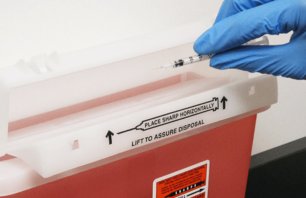Healthcare organizations such as suppliers, industry groups, and Group Purchasing Organizations (GPOs) should discuss, plan, and prepare regularly for high-consequence infectious diseases (HCIDs), including but not limited to viral hemorrhagic fevers (VHFs) and special pathogens.
Accreditation organizations, such as The Joint Commission, have standards designed to support infection control and emergency preparedness and management measures for wastes generated from the diagnosis and care of patients suffering from HCIDs and special pathogen diseases. The U.S. Department of Transportation (DOT) classifies the waste generated from the diagnosis and care of patients with some of these diseases as Category A infectious substances when transported for disposal, including transport preparation.
Unlike regulated medical waste (RMW), Category A wastes can cause permanent disability or death. Therefore, waste generated by VHFs cannot be transported as RMW, according to DOT regulations. The Pipeline and Hazardous Materials Safety Administration (PHMSA) interagency guidance provides more information and direction for identifying Category A wastes.
Under Special Permit 16279, the DOT requires proper packaging of certain Category A wastes generated from patient care for safe transportation for ultimate disposal. This permit does not cover all potential or emergent VHF diseases* – it only includes Ebola Virus Disease, Lassa Virus Disease, and Marburg Virus Disease wastes. Stericycle’s packaging guidance for Ebola, Lassa, and Marburg wastes reflects the current requirements outlined in the permit.*
Stericycle further recommends reviewing additional resources provided by industry groups, such as National Emerging Special Pathogens Training and Education Center (NETEC), Centers for Disease Control and Prevention (CDC), and state departments of health, for additional guidance.
Managing Category A Infectious Substances
Managing Category A infectious substances safely is a critical task, particularly when dealing with pathogens like VHFs, which can generate large quantities of infectious waste. These diseases are associated with severe symptoms and extended hospitalizations, significantly increasing the risk of transmitting life-threatening illnesses.
Organizational Policies
Your organization should have its own policies and procedures for waste classification and management. These policies should consider regulatory requirements, industry best practices, supplier requirements such as waste acceptance, and other relevant factors.
Effective, compliant, and safe management of infectious waste generated from the care of patients with suspected or confirmed HCIDs and special pathogens starts with having a well-developed plan, including the following:
Understand Potential Wastes and Associated Requirements: Correctly identifying and segregating Category A waste from other types of waste starts with understanding the associated requirements, including regulations, industry standards, supplier requirements, and your own policies. This will drive your waste management plan.
Accurate waste classification is crucial to protect your employees, your community, and your organization, and to ensure responsible and sustainable waste management.
Waste Acceptance Polices and Supplier Requirements: Waste acceptance policies are the requirements of a waste vendor dictating what they will or will not accept and under what conditions. Your organizational policies should also consider your vendors’ waste acceptance policies and alignment with your internal waste management policies.
Stakeholder Engagement: Engagement with all stakeholders that provide support and care of patients and are involved with the management of wastes generated in patient care should be consulted as you develop your waste management plan. This includes stakeholders within your organization, some of which may include risk management, infection prevention, safety, support services, and purchased services, as well as external partners, including your waste vendor, GPOs, industry associations, and regulatory agencies.
How is Waste Moved in the Facility: Suspected and confirmed patients who may generate Category A waste require more resources, such as dedicated storage areas. Suspected Category A waste should be stored separately until a confirmed diagnosis. A plan on how this waste is moved to these storage areas should be developed.
Waste Management Plan Development
To prepare an effective waste management plan for handling special pathogens waste, the CDC recommends healthcare facilities:
- Comply with all applicable federal, state, and local regulations for handling, storage, treatment, and disposal of special pathogen waste. Check with local public health departments for more information.
- Establish effective communication and ensure communication between healthcare facilities, waste management vendors, and federal, state, and local regulators.
- Determine whether you can and will inactivate waste onsite or offsite. Special pathogen-associated waste can be inactivated through incineration or autoclaving, which can occur onsite at the healthcare facility or offsite at a waste vendor facility. It’s important to keep in mind that if you are treating waste onsite that you have appropriate permitting and confirm that your municipal solid waste hauler will accept treated waste from patients with HCIDs. If transporting waste offsite for treatment, there are additional packaging and transportation considerations. Comply with federal, state, and local regulations.
- Train the team. Identify a waste management team and train those responsible for handling, packaging, storing, and transporting the waste. Training should cover wearing appropriate personal protective equipment (PPE) and the protocols for bagging and packaging waste.
- Conduct a hazard assessment, select appropriate PPE, and train staff. Use PPE according to the Occupational Safety and Health Administration’s (OSHA) Act of 1970 requirements, including the Bloodborne Pathogens (29 CFR 1910.1030) and PPE (29 CFR 1910.132) standards, other requirements under OSHA, and your facility policy.
Stericycle has over 30 years of experience serving hospitals and health systems through public health threats, including VHF-related waste such as Ebola. Stericycle is well-equipped to assist with your Category A waste management requirements.
* As of this publication.



